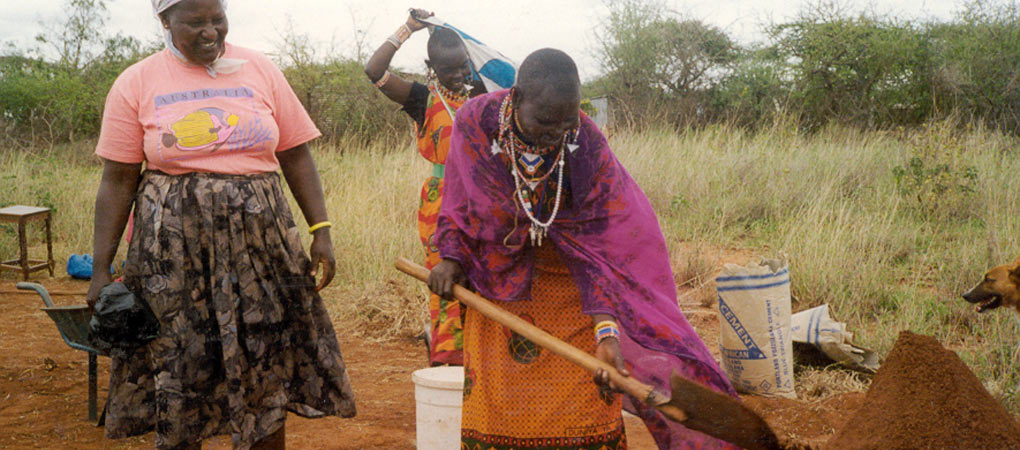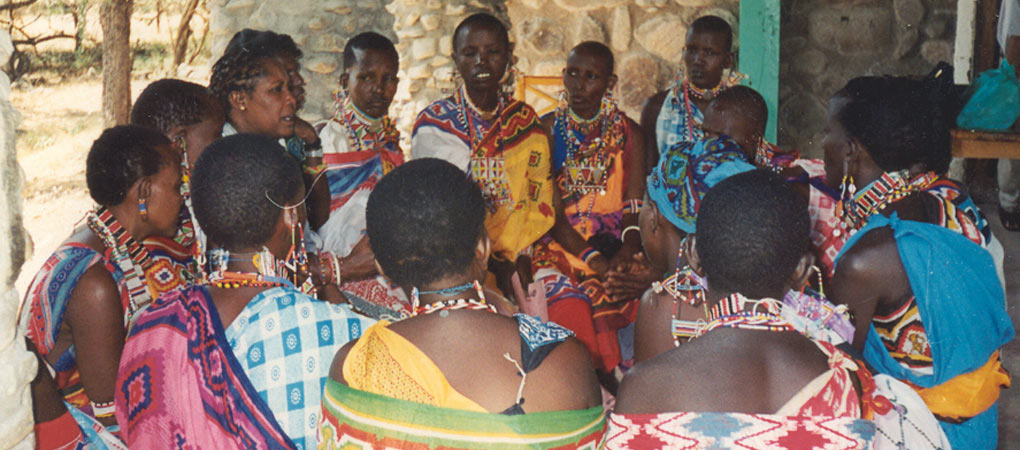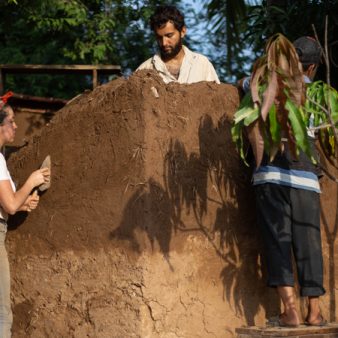Initiated in response to the changing livelihood needs of the nomadic Maasai population, this project provides technical skills and advice on appropriate technologies and durable building materials to pastoral communities in Kenya that are increasingly opting for permanent accommodation. The project seeks to build the capacity of women groups, artisans and local institutions to design, plan and manage their shelter improvements as well as establishing viable income generating enterprises through the identification of business opportunities, skills development and linkages to credit. To date over 300 individual houses have been improved incorporating water and sanitation facilities, as well as reducing indoor air pollution, 53 artisans have been trained in building and construction and 400 women are involved in micro-enterprise activities.
Project Description
Aims and Objectives
- To enhance access to improved affordable housing for pastoral communities in Kenya and East Africa as a whole.
- To develop the skills of both male and female artisans in the appraisal, design and construction of appropriate building technologies and water sanitation.
- To build awareness of hygiene and sanitation facilities.
- To build the capacity of women groups, artisans and local institutions to design, plan and manage their shelter improvement initiatives to meet changing livelihood needs.
- To stimulate the establishment of viable income generating enterprises through the identification of business opportunities, skills development and linkages to credit.
The Magadi Division of Kajiado District of Kenya is estimated to have a total of 25,000 people living in an area of 2,640 km2. This is a semi-arid degraded environment and population pressures and the expropriation of large parcels of high potential land have marginalised the families in pastoral societies. In the traditional nomadic lifestyle of the Maasai, houses are built that are semi-permanent and cannot withstand the harsh weather conditions. The materials used (grass, twigs, cow dung, anthill soil) degrade very quickly and it is usually the women and children who carry out the constantly needed repairs. Changes in the traditional nomadic lifestyle mean that the Maasai people are increasingly opting for permanent accommodation.
Women are the sole builders of these traditional houses that are arranged in compounds known as Enkaji. The traditional house is very small with no windows and a low roof. Vermin and fire are constant threats.

The Maasai community approached ITDG to seek a solution to their housing problems.
A participatory needs identification was carried out and participatory research into the most appropriate building technologies prior to any houses being built. As a result of this research designs were developed and demonstration units were built. Training sessions and peer exchange visits were carried out to share experience. Community training was provided in income generating activities. To date over 300 individual houses have been improved incorporating water and sanitation facilities as well as the indoor pollution interventions. Wide gutters and water collection facilities enable the local rainfall to be gathered and stored. Materials used for construction include locally available stone, sand and timber (for posts).
The community has played the major role in the development of the project. Training was provided in the appropriate building technologies. The development of local skills means that there is a large skilled labour pool to help families build their own homes. Since the building design has not changed significantly from that of the traditional design it is easily accepted in the culture. The main differences are the higher roof and the larger windows and doors in the house. Solar cookers require less time to be spent in fuel gathering than the traditional fuel wood stoves.
The Ministry of Commerce and Trade provides training in micro-enterprise development and business skills. The Ministry of Housing provides skills in appropriate building technologies to local artisans. This support is anticipated to continue once ITDG exit from the project. The project was funded by Danish aid which ended in 2001. The Massai Integrated Development Partnership Project has been established with a range of partners and local community that continues to finance the project. Fund raising is carried out by the local community.
Why is it innovative?
- Use of durable materials for roofing and walls rather than the degradable products used previously.
- Use of gutters for water harvesting.
- Provision of ventilation facilities with eaves, smoke extraction chimneys and windows that bring in light and fresh air.
Promotion of micro-enterprises that were previously unknown in the community. - Incorporation of sanitation facilities into the houses, with pit latrines incorporated into schools and social centres all over the district.
What is the environmental impact?
Previously there was excessive use of local materials and this was depleting the local environment. Now that more durable houses are built using more conventional materials there is less pressure on the increasingly arid environment. The sand and soils used in the construction process are locally available and are unlikely to be depleted. Water collection using gutters and large storage jars enables water to be collected and used. This means that much time and effort is saved for the women who previously had to walk long distances to fetch water.
Is it financially sustainable?
Skills and knowledge have been transferred and are now independent of the funding stream. People provide their own materials and labour to build their new homes and these are not funded by the project. An exit plan is in place for 2007 when full financial sustainability is expected. Since the building materials used are available locally and do not need frequent replacement, the houses now being built are more affordable to the families than the previous ones which needed to be replaced annually. Much time that was formerly spent by the women on housing construction is now spent on income earning activities, the profit from which is used to improve people’s homes.
What is the social impact?
Community group meetings and development activities have served to bring together groups within the community to act together for its greater good, for example water projects, building of schools and cooperative business ventures have all increased community interaction and cooperation. Local communities are empowered to access information and to lobby for services. Trained artisans can now solicit for their own contracts and from the skills acquired can build standard houses. The business-trained groups have a competent knowledge of bookkeeping and management of their businesses. Women have gained confidence and are able to express themselves in meetings and voice their grievances without conflict within the male dominated society. Local women leaders have emerged due to good governance training.
Evaluation
As a result of the improved housing project the following have been achieved:
- Reduced number of household accidents due to improved lighting from having bigger windows and a higher roof.
- Reduction in communicable diseases due to the introduction of sanitation.
- Reduced incidence of eye cataracts and lung disease due to improved ventilation.
- Greatly reduced number of vermin and rodents in the houses.
- Safe water is now available from the roof catchments.
- Increasing wealth of the Maasai communities through small business creation.
- A reduction in the number of trees being cut.
- Knowledge of rights and having the necessary skills to demand them.
- Training in micro-enterprise development, business management, book keeping and marketing has enabled over 400 women to have a regular source of income and to increase their wealth.
- 56 artisans have been trained in building and construction and are now earning a living with the skills gained. Other small businesses include building materials production, market gardening, small retail, small animal rearing, weaving and metal waste collection.
Transfer
To date four other divisions of the Kajaido Ditrict of Kenya have replicated the housing technology after an exchange visit to the region and meeting with the community.
A wide range of other organisations are now using the building technologies developed in this project.
Partnership
Local community, NGO, donor agency



